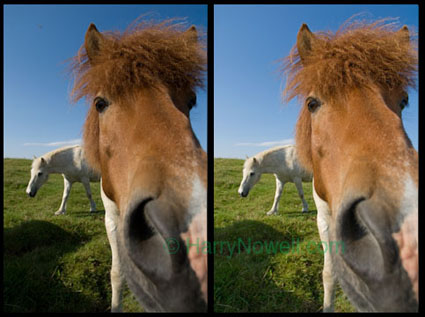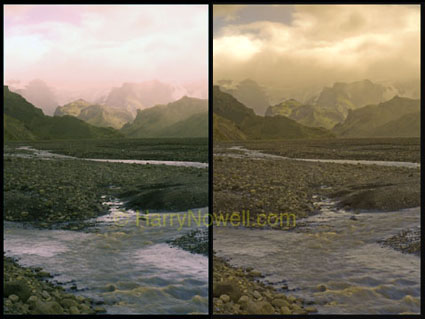Exposed! :: Post-processing - Cheating or tweaking? ::
© Copyright 2009. All Rights Reserved.
Contents
"But that's cheating!"
It's a common response when people discuss tweaking or 'post processing' work. Some people see it as a regular part of their work, others see it as unnecessary, even unethical.In this edition of Exposed! we look at what happens after you close the camera's shutter. We discuss the options and ethics of tweaking photos.
What is post-processing anyway?
There are many parts to creating a photograph that can be roughly separated into pre-click and post-click — what happens before and after you depress the shutter. Post-processing happens after the film is processed in film photography, or the sensor has finished sensing in the world of digital photo.
'Post' involves any manipulation after the photo has been captured - it often includes software such as Adobe Photoshop, the industry standard, or relatively new programs like Adobe Lightroom or Apple's Aperture.
Lightroom and Photoshop do similar but different jobs. Photographers use Lightroom as an editing, archiving and light manipulation tool to adjust colour balance or tidy up blemishes. It can also help 'maximize exposure data,' bringing out detail you cannot see - effectively maximizing the data captured.
See the Icelandic horses, below. On the left is the original capture complete with a dust spot and dark shadows. On he right notice the better shadow detail and detail in the horse's eye - the data was there - Lightroom made it visible. Also notice the brighter areas (white horse) have not changed - the exposure has not changed - data has been optimized. A good monitor is important to see the details.

Icelandic Horses Icelandic Photo Tour
Photoshop is used more for larger manipulation projects such as importing photo elements or drastically changing the look of an image.
Press photographers often use more basic software when minutes count for tight deadlines.
Post-processing is no substitute for good photo skills! Do your best to get the photo perfect with the camera. Underexposed (or gray) snow, focus issues, and poor compositions that "need" cropping are jobs to be corrected in the camera - not the computer!
The film process and scanners
Traditionally, the dark room offered similar post-processing options as modern computer software but, more and more, scanning and software manipulation are becoming popular options for film manipulation.
If you choose to invest in a scanner, research your options carefully. Inexpensive scanners produce mediocre or poor results compared to high-end drum scanners or virtual drum scanners. The cheaper scanners attempt to scan a 'flat' piece of film, a virtually impossible task that produces focus problems. Drum or virtual drum scanners scan a curved piece of film ensuring it is flat (and in focus) on one axis. High-end scans will also produce better details and depth in the photo.
Ethics
Many people balk at the idea of changing the raw data from their camera. But any photo is an interpretation of reality. Your choice of recording media -Digital sensor? Fuji Velvia? Kodachrome? - already give different interpretations of the same scene.
Sometimes the photos you see are fabricated from fragments of different photo elements. It can be easier and cheaper to create a photo from elements than to produce it as one shot. The effects can be stunning and time consuming. Is it real? No. Is it fun? Yes! Is it ethical? Maybe.
How much tweaking is ok? And when?
These are tough questions!
Here are some general ideas of how post-processing could be used in different situations:
- Editorial work - Ideally editorial work should depict reality. Aside from a simple tidying an editorial photo should depict reality and nothing else.
- Commercial or advertising work - Hmm, tricky. Sometimes reality is needed. Sometimes fantasy is required.
- Artwork - Anything goes... unless you are looking to depict reality!

Thorsmork
Icelandic Photo Tour
Pro Perspective
Almost every photo I hand in to an agency or client gets some polish in post-production software. Polish, however, is different than photo alteration or reconstruction.
My photo work receives different treatment depending on each situation.
- Wynton Marsalis shot for the Ottawa Sun? Basic processing and send - very tight timeline.
- Stock assignment for the Canadian Senate? Mild processing
- Editorial Ice Fishing Assignment for Canadian Geographic Magazine? Basic processing
- Stock work through AGEFotosock? Anything goes!
Notice the photos of the mountains of Thorsmork, Iceland, above. Shot digitally with a Cokin Blue Yellow Polarizer provides the capture on the left. A little Lightroom on the right maximizes exposure data and punches up the colour. All the data is there - just needs some polish! - Artwork at ChelseaGallery.ca? Anything goes!
- Weddings or Portraits? Mild tweaking to make the client look good!
- Editorial Portraits for Ottawa Magazine or Canoe and Kayak? Mild tweaking.
Really, my style of work lends itself to minimal post-processing - but I will adjust as needed. In general I make the photos as perfect as possible in the camera. Post-processing is not designed to fix sloppiness or mistakes but to enhance.
Homework
After clicking the shutter import the photo into Lightroom or Photoshop and explore the options available. How would you change the photo for :
- an ad?
- an editorial assignment?
- art work?
Final Frame
Your photo journey only starts with the camera. It may finish in many different ways...
Take photos. Have fun.
